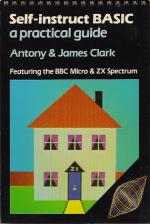
ZX Computing
 1st April 1984
1st April 1984
Categories: Review: Book
Author: Patrick Cain
Publisher: Pitman Publishing
Machine: BBC/Spectrum
Published in ZX Computing #12
Self-Instruct Basic: A Practical Guide
It's said that first impressions go a long way: my first impression of this book certainly didn't take it any further than the floor. As I opened the cover I thought 'Self Destruct Basic' might have been more appropriate! For some reaon the publishers, Pitman, have bound this volume in a fashion similar to a secretary's shorthand pad. Opening it for a second time, with a bit more care, I began to form second impressions of the novel binding and the contents.
Once mastered, the cover proved to be a great success. This book, by father and son authors Antony and James Clark, is intended to be a step by step guide to beginners on both the ZX Spectrum and the BBC Micro Computer, and as a teaching aid the cover folds into a readily accessible support for the inner texts. Having many times in the past all but lost concentration trying to type a listing into the computer while being continually frustrated by losing my place on the page, I found this simple and effective solution most convenient.
But let's not judge a book by the cover alone, what of the text that is so adequately supported? The book is aimed at beginners and assumes little more than that the reader has successfully set up the computer and glanced over the manual. I should dispute, however, that it is suitable for users as young as nine years, if for no other reason than that they at such an age are likely to lose interest very quickly in such a factual treatment of the problem. Readers who can sustain interest are intended, on completion, to be familiar with a full range of programming instructions and to be aware of their usefulness. The topics covered are strings, string arrays, input and assignment statements randomize, FOR...NEXT loops, screen formatting and all commands necessary for their implementation. Also included are examples and hints on program writing and programming style.
New users wil find that there is no shortage of books with similar material, so other than the novel binding, what have Messrs. Clark included to make their book worthy of any note? The strength of Self Instruct Basic is not the content, which is no more than might be expected in an elementary book, but the method of presentation. From what I can remember of the hours I have spent close to sleep at the back of a lecture hall as a student teacher, the technique has much merit.
In each section there is an introduction to the topic, an example of its use and a short discussion to hindlight and reinforce the principle. Further, there are suggestions for putting the newly discovered technique to use and questions to ensure that the theory has been properly learned. In the main though, this is a book to be used when sitting in front of the computer. Any computer user worth his 'chips' knows that hands-on experience is the only way to develop skill - this book is intended to be used as a companion and guide while gaining that experience. It is a well structured course in basic programming and should be followed, as suggested, in the order laid out. To gain all the book has to offer the reader should be prepared to be a good student following that course and investigating the projects suggested. All that it has to offer is a good grounding in Basic for both Spectrum and BBC users but that is no small task.
On first impressions, Self Instruct Basic may seem flimsy; but as a guide to new users it has my 'backing'.
Self Instruct Basic: A Practical Guide is written by Antony and James Clark, published by Pitman and costs £4.95. ISBN 0 273 02020X.


